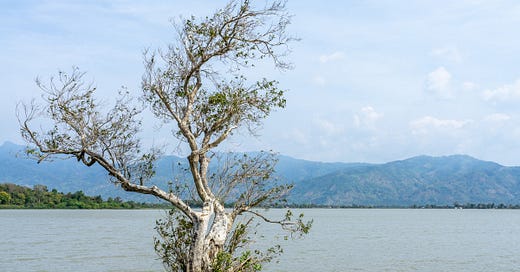Good morning! Hello to all new readers - thank you very much for signing up. This is the latest free-to-read edition of the Vietnam Weekly. On Monday I published an article for paying subscribers about the challenges facing affordable housing development. You can upgrade to receive all future exclusive stories and access the full archive for US$5/month or US$50/year below.
As always, if you have any questions or comments, just hit ‘reply’ to this email - I’m more than happy to chat.
On to the news.
Carnage in Dak Lak
A note for readers - this is one I need to be careful with.
In a shocking development for a country where major incidents of violence are exceptionally rare, in the pre-dawn hours of last Sunday morning a group of assailants on motorbikes attacked the People’s Committee buildings and police offices of Eu Tieu and Ea Ktur communes south of Buon Ma Thuot in Dak Lak Province.
The assault left nine people dead, including four police officers, two commune officials, and three residents. At least two other police officers were injured, including one who recounted the attack to VnExpress: he recalled driving up to the committee building in Ea Ktur only to be immediately stabbed and barely escaping as men threw firebombs into his car.
It’s not clear whether any of the assailants were injured or killed, but the incident kicked off a military-led hunt across Dak Lak during which residents were urged to remain in their homes.
Information related to this attack has been limited to official announcements, so there is a lot we don’t know, but as of Wednesday afternoon, 45 people had been arrested for allegedly taking part. Several hostages were freed in this process.
Some of the captured individuals appeared on VTV, with one saying the “leader” told him to “shoot everyone he saw” while promising he would “become rich.”
Guns, knives, petrol bombs, and grenades were reportedly used in the assault, while photos of the aftermath show torched offices and windows shattered by bullets.
According to Tung Ngo of Channel News Asia, earlier this week the Dak Lak government issued an appeal calling on the public “to unite, place trust in the Party, authorities' policies & governance [and] ‘don't listen, don't trust, don't follow’ reactionary subjects.”
Social media speculation regarding this event is rampant, but I won’t be engaging in that here. Five people have already been fined a collective US$1,510 for posting false information about the attack on Facebook.
There is a very complicated history between the state and the Central Highlands’ ethnic minority groups, who fall under the umbrella term of Montagnards (though I believe this is less commonly used in the contemporary context). Land use is one of the primary drivers of this tension, and there is a lot of information regarding this history online - though much of it on websites that are blocked in Vietnam.
Current problems in this area are left out of the official narrative, but such a brazen attack certainly couldn’t be ignored. This is the most high-profile eruption of violence since the sensitive Dong Tam incident on the outskirts of Hanoi in January 2020. That was related to land, but again we don’t know what led to these events in Dak Lak.
The Cambodian government, which has its own deeply complicated history with Vietnam’s ethnic minority groups, has stepped up security along its border with Dak Lak.
For now, the Ministry of Public Security continues to search for anyone else involved in the assault while calling for them to come forward. Residents have also been asked to inform police if they know of any suspects in hiding.
The four police officers and two commune officials who were killed have been made official state martyrs.
Tô Ân Xô, the MPS spokesperson, said the attackers were “organized, violent, bold, barbaric and inhumane.” We will surely learn more about this, though information will remain tightly controlled.
Serious Power Shortages
Northern Vietnam’s energy crisis, which I covered here last week, remains an enormous problem with a strong potential to worsen.
Unannounced cuts continue to hit parts of Hanoi (and beyond), with sudden outages making life in apartment complexes particularly difficult. In a preview of our possible climate future that would be rather on the nose in a TV script, dozens of families in the capital’s Chuong My District took refuge in a cave to beat the heat. (I did not have that on my ‘Vietnam 2023’ bingo card.)
Given how damning this shortage is for those in charge of the power sector, I continue to be impressed by local media’s tough coverage: VnExpress called this a ‘desperate power shortage’ while SGGP noted the risk of a ‘prolonged electricity shortage.’
Portable power stations are in high demand, and while heavy rain hit parts of the region this week, hydropower reservoirs are still critically low. Northern thermal power plants, meanwhile, are short over 1 million tons of coal through July. (Though an ensuing article said domestic coal producers will produce more than expected the rest of the year, so not sure what to make of that.)
In that context, the government of Quang Tri Province has proposed building a 160-kilometer-long conveyor belt (not a typo) to transport coal from Laos to the My Thuy port.
Around Hanoi, water levels on the Da River are so low that water utilities are struggling to even supply water to customers.
Beyond residential life, industry and tourism are also getting hammered.
Officials have reportedly asked Foxconn to stop evening production at its factories for 20 days, and EVN asked industrial parks around Hanoi to try and reduce electricity use by 50%.
Three major Vietnamese logistics and shipping associations have demanded help amid repeated outages at Hai Phong’s ports. Those facilities are key outlets for the north’s tech-heavy manufacturing base.
Tourists are ending trips to the north early or canceling their plans altogether, while some hotels in blackout-stricken Ha Long City are charging guests electricity generation fees.
On Wednesday, EVN suspended the director of the National Load Dispatch Center, which operates transmission and distribution to ensure a stable power system. This comes a few days after the Ministry of Industry and Trade began an inspection of EVN’s power management and supply since January 2021.
Suffice it to say that this is all getting very messy.
On the analysis side, Nguyen Khac Giang discussed the increasingly critical need for further reform of Vietnam’s electricity system, especially when it comes to being more open to private investment. Reuters took a deeper look at the situation as well, noting that international partners are increasingly concerned about the JETP agreement.
PDP8 continues to be analyzed as well, but excitement over the plan has rapidly deflated. Orsted, the Danish wind power giant, recently said it has paused market development activities in Vietnam. Offshore wind makes up a large chunk of PDP8’s renewable energy goals, but no regulations for its development are in place.
Southern Vietnam remains in much better shape thanks to its existing base of solar and onshore wind - except for the 16,500 people in Tien Giang Province who lost power on Monday when a ship tore down several transmission cables. (I also happened upon a blackout in Thao Dien yesterday right after a power line exploded, leaving it burning in the middle of the road.)
Extra Links:
Calls grow for Vietnam to do more on plastic waste (Mekong Eye)
World's first vaccine against deadly swine fever nears approval in Vietnam (Reuters)
The Vietnamese octogenarian fighting for Agent Orange victims (AFP)
Ngõ Nooks: A Ngõ Cafe Houses Big Dreams for Buôn Ma Thuột Beans (Saigoneer)
Have a great weekend!
Mike Tatarski





Another good one Mike
Thanks